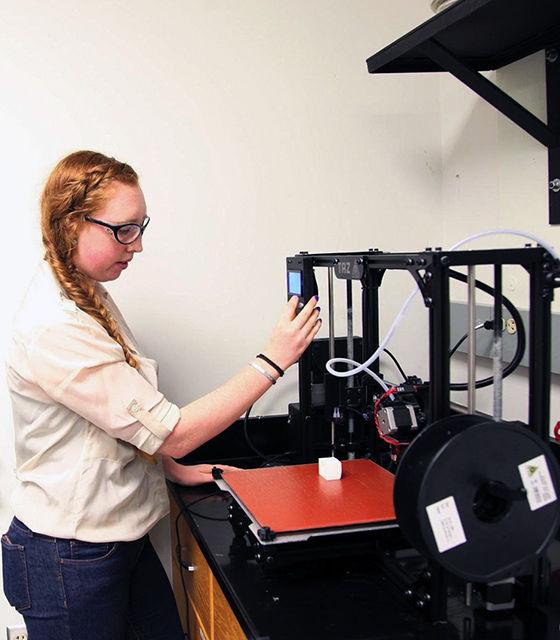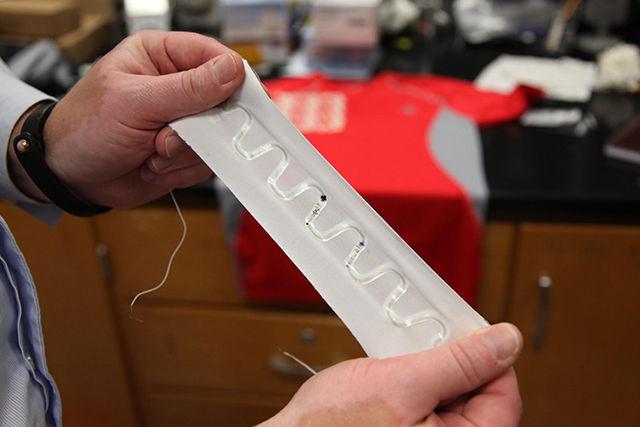Monitoring your health could be as easy as throwing on a T-shirt. With wearable electronics, your clothing could become an essential part of your wellness.
Jesse Jur, assistant professor of textile engineering, chemistry and science, and his research group, Nano-EXtended Textiles (NEXT), at the College of Textiles, are studying new ways to integrate electronics into garments. These methods can be applied inexpensively to the large-scale manufacturing that’s required in the textiles industry, according to Jur.
One of NEXT’s projects explores prospective ways to power these electronic devices, such as thermal and mechanical energy harvesting from the body.
“If we can reduce the amount of power that’s required for our devices and how we communicate that data, then we can use just our body’s energy to power up the entire electronics system,” Jur said.
Thermal energy harvesters produce power based on differences in temperature, which involves the heat from your skin and the air around it. Though these devices are generally used in applications with high-temperature differences, such as a car exhaust, NEXT is using the implement at lower-temperature differences, according to Jur.
“We have to be careful how we integrate the devices into the garment so we can harvest the amount of power that we need,” Jur said.
An alternative method is energy harvesting from the mechanical motions of the body, such as joint movements, according to Jur.
“Our primary goals allow people to personalize their wellness and health,” Jur said. “Garments play an integral role in that. The types of garments that we use are what you would use in athletic apparel.”
Meshing fashion and performance is also an integral part of the process. Considerations such as durability, washability and function are crucial in order to culminate appeal.
“Through the technology that we developed most recently, we iron on the electronics, similar to putting a logo on a shirt,” Jur said.
NEXT has been working on a shirt that monitors one’s heart’s health. With sensors ironed onto the shirt, data is collected through the heart’s electrocardiogram signal, according to Jur.
“By measuring your heart’s electrocardiogram signal, you can understand a lot of heart health conditions that affect a large amount of the population,” Jur said.
The data could be sent to a cellphone, a doctor or stored to track how your heart is progressing over time. Potentially, the device could be used on animals to measure activity levels or general health.
“You can imagine it as putting a Fitbit on a dog or cat,” Jur said. “Other opportunities exist in putting the devices on wild animals, especially endangered ones, which could help ensure their safety.”
NEXT has ongoing research with Advanced Self-Powered Systems of Integrated Sensors and Technology (ASSIST), a Nanosystems Engineering Research Center funded by National Science Foundation.
“ASSIST’s vision is a wearable device that doesn’t have to be recharged; all you’d have to do is put on your shirt,” Jur said. “The shirt would operate seamlessly with your lifestyle. If you really want to achieve real-time monitoring in a way that’s hassle-free for large groups of the population, you really have to move away from connecting with cords at some point.”
One of Jur’s past students, alumna Jazsalyn McNeil, designed a dress with wearable technology, representing health.
“We linked up the heartbeat to the lights integrated on the dress, so the dress actually beats with the wearer’s heartbeat,” Jur said. “The heart’s electrical signals are read by using different electrodes in the clothing, which generates a pulse for the lights.”
Jur will be presenting her dress as a part of his upcoming TEDx talk in Durham. TEDx, which is locally and independently organized, will be the first of its kind in Durham.
“The goal of any TEDx theme is to provide a way for the audience to focus — allowing any idea under the sun,” said Jack Derbyshire, organizer of the event. “Our theme is ‘Centers and Edges,’ which challenges the audience and the speakers to explore centers and edges of your field of study.”
The theme gives rise to questions pertaining to what is important and central to your life. On the contrary, it addresses the edges in your life.
“It’s like looking down the edge of a cliff; it’s kind of an uncomfortable experience, but there’s growth in looking up,” Derbyshire said.
TEDxDurham will take place in the Carolina Theatre July 9 from 9:30 a.m.-6:30 p.m.
“I’ve done a lot of public speaking, but I haven’t in a TEDx-talk format,” Jur said. “I’m looking forward to engaging with the public in this way and sharing all of the great things we do here at NC State.”
Tickets for the event can be purchased here.
A version of this article appears in print on July 7, 2016 on page 7 with the headline “Future of Wearable Technology Headed to TEDx.”
Methods to heat laminated electronics onto textiles are explored, similar to processes used to attach logos or tags onto garments.









